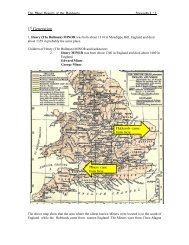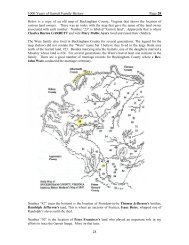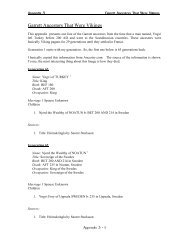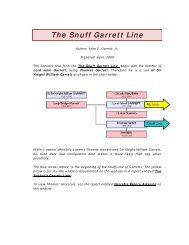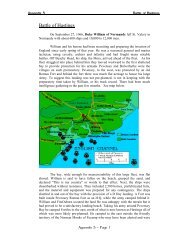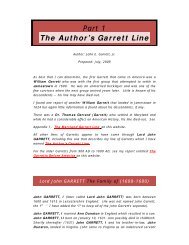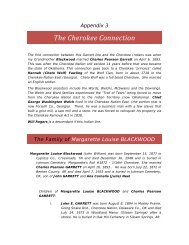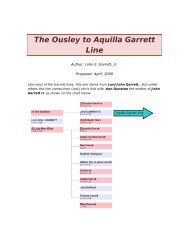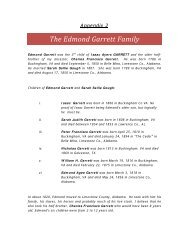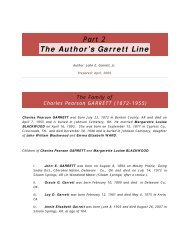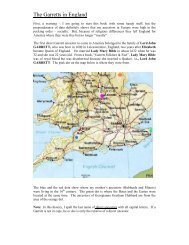The Maryland Garrett Line - Garrett Family Genealogy
The Maryland Garrett Line - Garrett Family Genealogy
The Maryland Garrett Line - Garrett Family Genealogy
Create successful ePaper yourself
Turn your PDF publications into a flip-book with our unique Google optimized e-Paper software.
<strong>The</strong> <strong>Maryland</strong> <strong>Garrett</strong> <strong>Line</strong> Page 16<br />
Dr. Thomas Gerard was one of the first doctors or "chirurgeons" in the province.<br />
In 1639, he was appointed conservator of the peace for St. Clement’s Hundred. In<br />
1641 he was chosen burgess from St. Clements and two years later, appointed as<br />
member of the Provincial Council & Judge of Provincial Court. Other appointments<br />
and commissions followed, such as one to look after his Lordship's property and<br />
another to advise concerning Indian problems.. Gerard continued as a member of<br />
the Council until the time of Fendall's Rebellion in 1659 and also served as a Judge of<br />
the Provincial Court during this period.<br />
Gerard was not only active in the practice of medicine, member of Council and Court,<br />
but was also an able farmer, a manufacturer of liquors, particularly peach brandy,<br />
and a breeder of fine cattle. Apparently, he was also an excellent sailor from the<br />
many trips that he made by boat between Longworth Point and St. Mary's City.<br />
During the Puritan uprising (1654-1656) Gerard was appointed one of Governor<br />
Stone's captains. He took part in the battle at Herring Creek where he was captured<br />
with the rest of Stone’s force. Although quarter had been promised, four of the men<br />
were executed by the Puritans and Gerard narrowly escaped with his life. After the<br />
difficulties with the Puritans had been resolved, Gerard returned to his duties as a<br />
member of the Council under the governorship of Josias Fendall.<br />
Dr. Thomas Gerard patented 1,000 acres south of the Potomac River on October<br />
18, 1650 in Westmoreland County, Virginia. He moved there after he lost his<br />
<strong>Maryland</strong> estates in the revolution of 1659 under his friend, Josias Fendall. To<br />
protest certain taxes that they thought unfair, the Assembly issued the first<br />
declaration of Independence in America and Governor Fendall proclaimed <strong>Maryland</strong><br />
a republic – which started the revolution of 1659.<br />
However, the rebellion collapsed in 1660, and Lord Baltimore, in a furious letter<br />
dated August 24, 1660, instructed his brother Philip Calvert, then governor, to deal<br />
harshly with GERARD, FENDALL, HATCH, SLYE and others who took a leading part in<br />
the revolt. <strong>The</strong>y could be sentenced to death, be banished from the province and<br />
suffer the loss of all their property. Gerard's manor lands and other property were<br />
seized, and he was banished. He retired temporarily to his lands across the Potomac<br />
in Westmoreland County, Virginia, a 3,500 acre holding, known as Gerard Preserve.<br />
In a few months, however, he applied to the <strong>Maryland</strong> Council for a pardon which<br />
was promptly granted. He was restored to citizenship in the Province but forbidden<br />
to hold office or to have a voice in elections. His lands and other property were<br />
restored to him.



